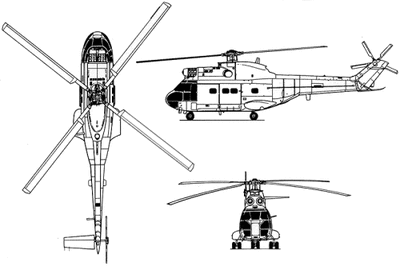Fri, Jan 24, 2014
Issued In Response To Offshore Oil Industry Super Puma Accidents
The U.K Air Accidents Investigation Branch is recommending that North Sea oil industry helicopter operators amend their safety briefings in light of an accident which resulted in multiple fatalities.

Special Bulletin S1/2014 was published on Thursday, January 23 concerning the accident to the AS332 L2 Super Puma helicopter, registration G-WNSB on Friday August 23. The accident occurred approximately 1.5 nm west of Sumburgh Airport, Shetland Islands.
This Special Bulletin is published to highlight a safety concern relating to pre-flight safety briefings, given to passengers, on the functionality of emergency equipment provided to them for UK North Sea offshore helicopter flights.
According to the bulletin, research has identified that in about 60% of all helicopter water impacts, the helicopter inverted or sank, immediately or after a short delay. A capsize often occurred before evacuation of the occupants could be completed. As a result, Emergency Breathing Systems (EBS) were developed to allow helicopter occupants to breathe underwater for a short period of time. The EBS can bridge the gap between the maximum breath-hold time of an occupant and the time required to complete an underwater escape, thereby increasing the chances of survival. EBS were introduced in UK North Sea offshore helicopter operations as a voluntary industry standard; at present there is no regulatory requirement for such equipment.
The pre-flight safety briefing material has been reviewed by the AAIB as part of its ongoing investigation. This has identified that the briefing material does not include fully representative information about the EBS. It does not highlight that the EBS provided may be a hybrid rebreather containing an air supply which is discharged automatically into the rebreather bag, or that the system can be used even if the wearer has not taken a breath before becoming submerged.

The AAIB has approached the main helicopter operators flying in support of the UK oil and gas industry, whose passengers are equipped with a hybrid EBS. Whilst operation of the hybrid EBS should be covered in initial and recurrent training, it is not explicitly described in the pre-flight safety briefing. The operators have undertaken to amend their pre-flight briefing material to include information that the hybrid system contains its own air supply which is discharged automatically, making the system usable even if the wearer has not taken a breath before becoming submerged.
More News
Ultrahigh Frequency (UHF) The frequency band between 300 and 3,000 MHz. The bank of radio frequencies used for military air/ground voice communications. In some instances this may >[...]
During The 7 Second Descent, There Was Another TAWS Alert At Which Time The Engine Remained At Full Power On October 24, 2025 at 2115 mountain daylight time, a Cirrus SR22T, N740TS>[...]
From 2009 (YouTube Edition): Educational Organization Aims to Inspire by Sharing Tuskegee Story Founding leader Don Hinz summarized the Red Tail Project’s mission in simple, >[...]
“This feels like an important step since space travel for people with disabilities is still in its very early days... I’m so thankful and hope it inspires a change in m>[...]
Also: New Katanas, Kern County FD Training, IndiGo’s Botched Roster, MGen. Leavitt Named ERAU Dean The Australian Transportation Safety Bureau (ATSB) has wrapped up its inves>[...]
 ANN's Daily Aero-Term (12.19.25): Ultrahigh Frequency (UHF)
ANN's Daily Aero-Term (12.19.25): Ultrahigh Frequency (UHF) NTSB Prelim: Cirrus Design Corp SR22T
NTSB Prelim: Cirrus Design Corp SR22T Classic Aero-TV: The Red Tail Project--Carrying the Torch of the Tuskegee Airmen
Classic Aero-TV: The Red Tail Project--Carrying the Torch of the Tuskegee Airmen Aero-News: Quote of the Day (12.19.25)
Aero-News: Quote of the Day (12.19.25) Airborne 12.17.25: Skydiver Hooks Tail, Cooper Rotax Mount, NTSB v NDAA
Airborne 12.17.25: Skydiver Hooks Tail, Cooper Rotax Mount, NTSB v NDAA




